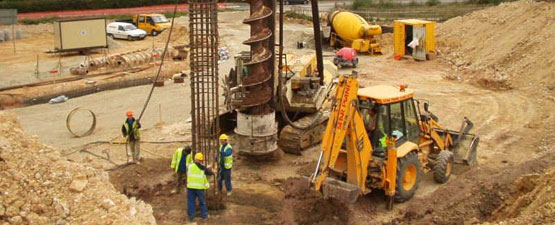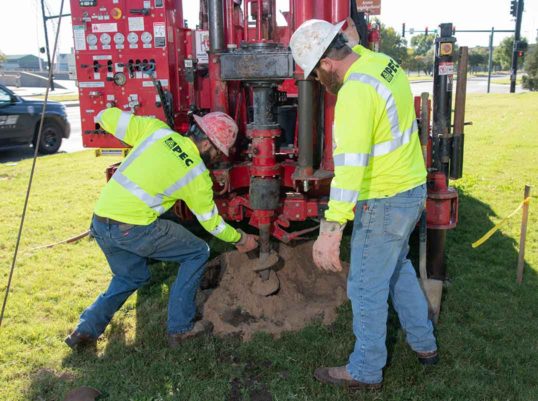Expert Consulting Engineer Solutions for Cutting-edge Infrastructure Solutions
Expert Consulting Engineer Solutions for Cutting-edge Infrastructure Solutions
Blog Article
The Interdisciplinary Approaches in the Geotechnical Sector: Linking the Gap In Between Design, Geology, and Environmental Scientific Research for Ideal Project Results
The assimilation of design, geology, and environmental science within the geotechnical market is not merely helpful; it is imperative for attaining ideal task end results. This interdisciplinary collaboration cultivates a thorough understanding of facility site problems, permitting cutting-edge options to emerge. By checking out crucial duties and effective instance research studies, we can uncover the vibrant interaction that drives task success. Nonetheless, obstacles remain in effectively handling these multidisciplinary efforts, questioning regarding prospective innovations and future trends. What techniques might arise to facilitate this vital cooperation and boost the effectiveness of geotechnical techniques?
Value of Interdisciplinary Partnership
The importance of interdisciplinary collaboration in the geotechnical sector can not be overstated. Reliable geotechnical tasks call for the assimilation of diverse experience from numerous fields, including engineering, geology, and ecological scientific research. This partnership ensures that all aspects of a job are taken into consideration, resulting in thorough options that deal with complicated challenges.
Interdisciplinary cooperation fosters development by allowing specialists to share insights and methods that might not be obvious when working in seclusion (engineer of record). By leveraging the staminas of multiple disciplines, teams can recognize prospective risks, optimize design processes, and improve the sustainability of geotechnical jobs. Such collaboration advertises an alternative understanding of site-specific conditions, which is crucial for accurate analysis and decision-making.
The intricacy of geotechnical jobs requires a coordinated method to problem-solving. Inevitably, interdisciplinary collaboration is vital for advancing best methods and achieving quality in the geotechnical sector.
Key Roles of Each Self-control
Cooperation amongst numerous self-controls is not simply valuable; it is vital for the effective execution of geotechnical projects. Each self-control-- engineering, geology, and environmental science-- plays an unique yet interconnected function that adds to forecast efficacy and sustainability.
Geotechnical engineers are largely liable for making structures and guaranteeing architectural integrity. They assess soil and rock residential or commercial properties to analyze load-bearing capabilities, offering important information for secure building techniques. Their proficiency allows the formulation of ingenious remedies to intricate difficulties.

Ecological scientists analyze the potential influences of construction on environments and water sources. They carry out environmental evaluations and establish mitigation strategies to decrease damaging impacts. By integrating eco-friendly factors to consider, they guarantee compliance with guidelines and advertise sustainability throughout the job lifecycle.
Instance Research Studies of Effective Assimilation
Successful integration of geotechnical disciplines can be exhibited with numerous case studies that highlight the effectiveness of teamwork in dealing with intricate engineering challenges. One remarkable example is the building and construction of the Hong Kong-- Zhuhai-- Macau Bridge, where a collective approach involving geotechnical engineering, geology, and ecological science was crucial. Rock hounds and engineers worked in unison to assess the seabed conditions and enhance the structure design, making certain stability and minimizing environmental effect.
Another impactful instance is the renovation of slope security in the San Francisco Bay Location, where look these up an interdisciplinary team integrated geotechnical evaluation with ecological assessments. By incorporating hydrological studies and geological surveys, the group efficiently identified prospective landslide threats and implemented effective reduction measures, boosting security check here and sustainability.
In addition, the redevelopment of Brownfield sites commonly requires a multidisciplinary strategy. In one instance in Chicago, partnership among geotechnical engineers, ecological researchers, and metropolitan coordinators led to the successful removal of polluted soil, enabling the safe improvement of the site into a community park. These study highlight that interdisciplinary partnership not only addresses technological difficulties but additionally promotes cutting-edge services that you can try here profit both jobs and neighborhoods.
Obstacles in Multidisciplinary Projects

Additionally, coordinating schedules and operations among numerous teams can be bothersome, especially when each discipline has special project turning points and deliverables. This imbalance can cause delays and raised costs. The difficulty of resource allowance likewise looms big; making certain that customized experience is readily available at essential points calls for mindful planning and foresight.
Finally, regulatory compliance postures another significant obstacle. Each self-control might deal with different regulative structures, and lining up these needs to satisfy job objectives can be complex and lengthy. Addressing these challenges demands solid leadership and reliable interaction methods to foster cooperation and make certain that multidisciplinary teams work cohesively towards shared objectives.
Future Trends in Geotechnical Practices
As the geotechnical market advances, arising patterns are reshaping methods to address the obstacles encountered in multidisciplinary projects - geotechnical engineers. One substantial trend is the enhanced integration of sophisticated modern technologies, such as expert system and artificial intelligence, right into geotechnical evaluation and layout. These innovations enhance anticipating modeling and danger analysis, making it possible for engineers to make even more educated decisions throughout the project lifecycle

Additionally, the adoption of electronic doubles and real-time tracking systems is becoming a lot more common. These devices facilitate recurring assessment of dirt conditions and structural performance, enabling timely interventions when problems occur.
Final Thought
In conclusion, the integration of design, geology, and environmental scientific research is crucial for achieving optimal results in the geotechnical industry. Successful case researches highlight the advantages of this technique, while recognizing the difficulties dealt with in multidisciplinary jobs.
The assimilation of design, geology, and environmental science within the geotechnical market is not merely beneficial; it is necessary for attaining optimum job end results. Reliable geotechnical tasks require the integration of diverse proficiency from various fields, including engineering, geology, and ecological scientific research.Navigating the intricacies of multidisciplinary tasks in the geotechnical industry provides several considerable challenges.As the geotechnical sector advances, emerging trends are improving methods to resolve the obstacles encountered in multidisciplinary tasks. Geotechnical designers are significantly teaming up with environmental researchers to guarantee that tasks straighten with sustainability objectives and abide with regulative demands.
Report this page